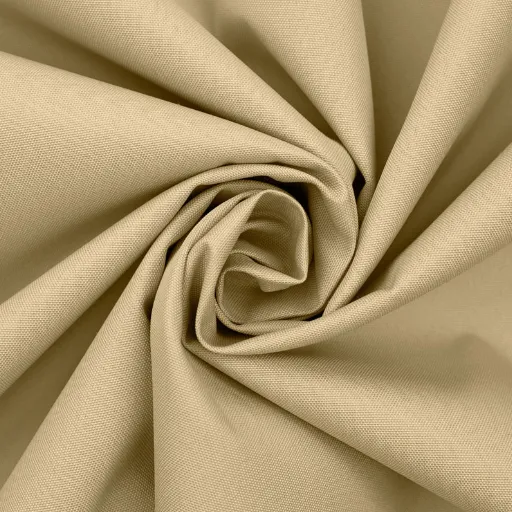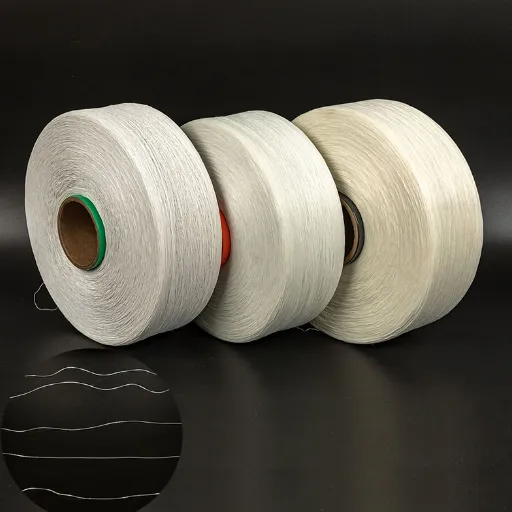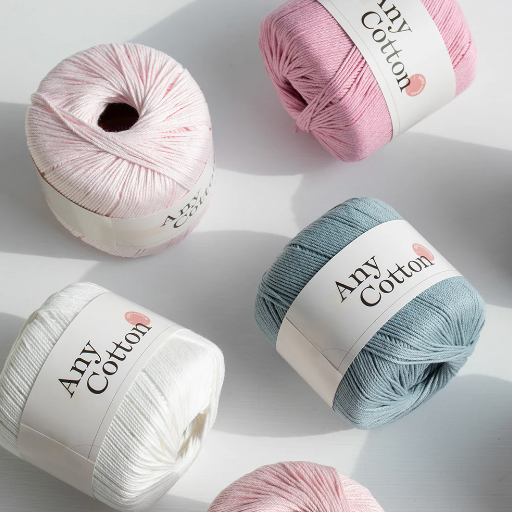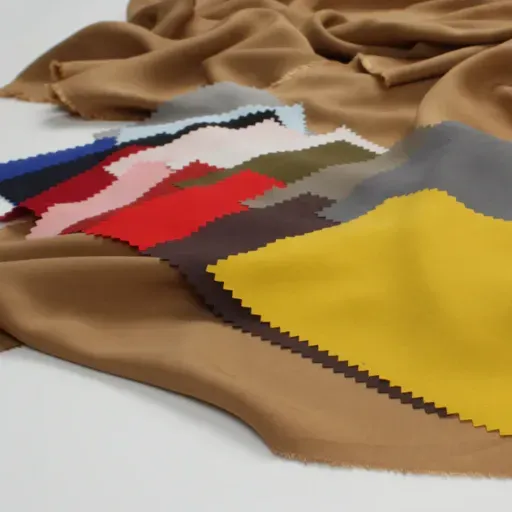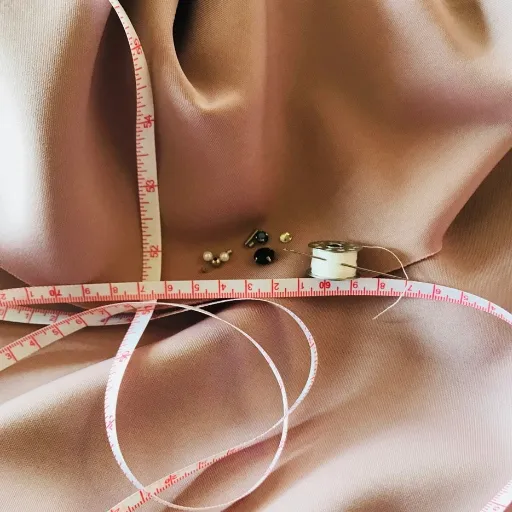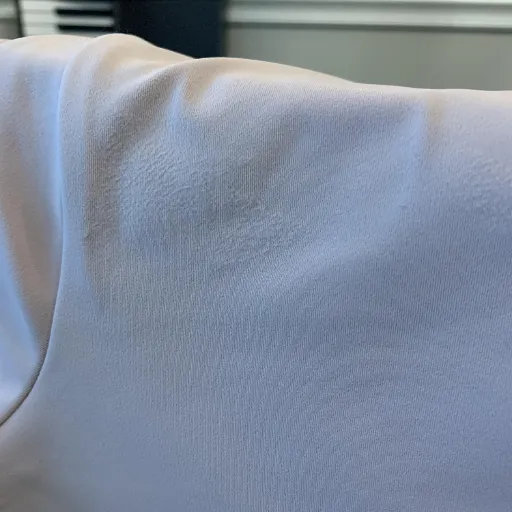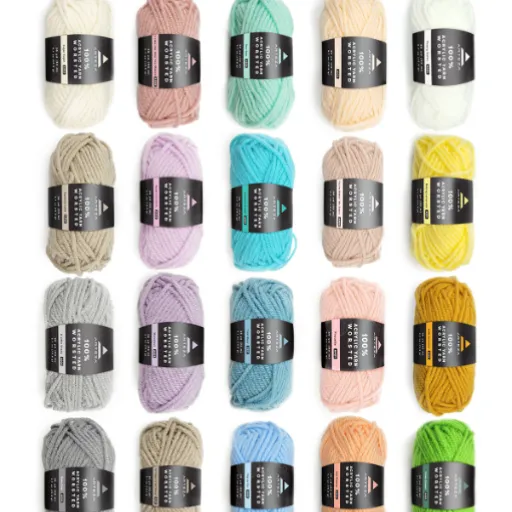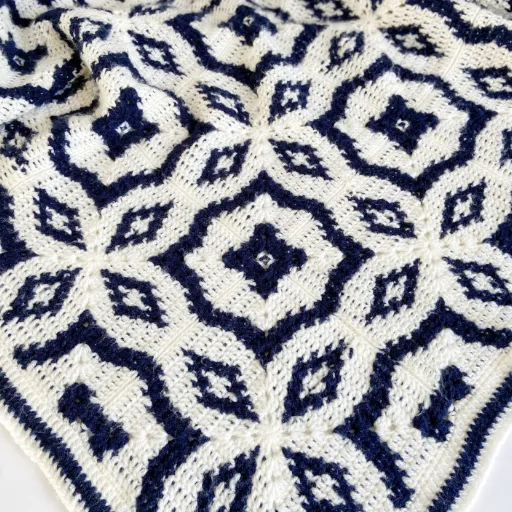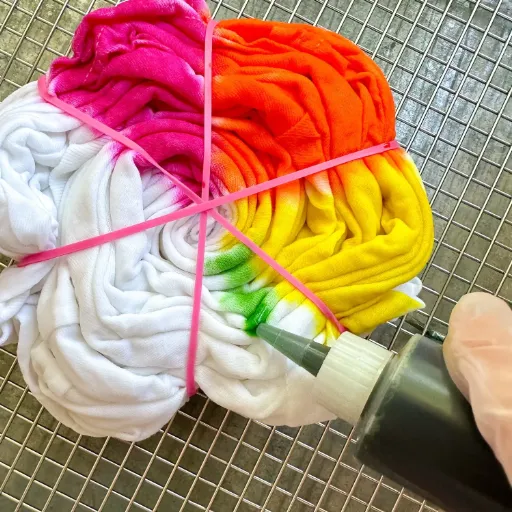Acrylic yarn is now considered the “go-to” material by all knitters, crocheters, and crafters globally when it comes to making things. What are the reasons for the high demand of acrylic yarn, and how do you pick the right type for the project you are about to start? This guide takes you on a journey through the realm of acrylic yarn, breaking down its types, special features, and areas of use. If you are a master maker or just a newbie in crafts, this article will still enlighten you with information that will help you make choices, save time, and boost your artistic projects. Let the world of acrylic yarn unfold its mysteries and see for yourself why this material is a must-have in your crafting toolbox!
What is Acrylic Yarn?
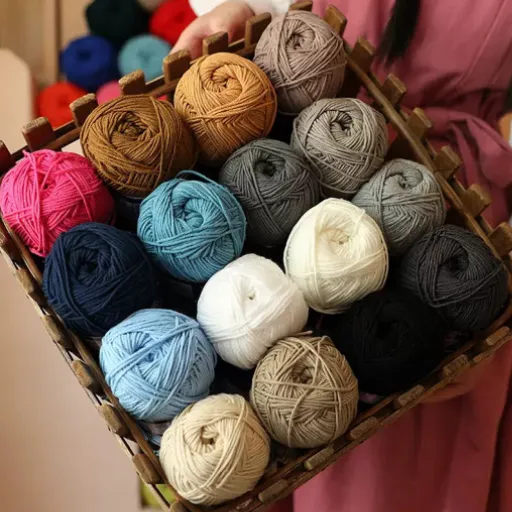
Definition of Acrylic Yarn
Acrylic yarn is a man-made fiber made from a polymer called polyacrylonitrile which is the main constituent of acrylic fiber. It is produced through a chemical process where acrylonitrile is polymerized and then spun into very thin strands. This material is developed to imitate the characteristics of natural fibers such as wool and at the same time provide more advantages like durability and low price.
One of the main features of acrylic yarn is its wide range of applications. It is non-heavy, pleasant to touch and warm, therefore it can be used in different types of crafts like clothing, blankets, and snoods. Moreover, acrylic yarn is very strong against damage, which means that it lasts for a long time and doesn’t lose its form or color even after frequent usage and washing. Besides, it is usually washer-friendly which makes it a great option for items that are not asking much care.
In addition, another merit of acrylic yarn is its price. Unlike natural fibers, which are usually very expensive, acrylic yarn, though, has a much lower price; hence, the crafters are free to make huge projects without the fear of their budget being overrun. What is more, acrylic yarn is available in a vast array of colors and textures which definitely contributes to its popularity among both novice and professional artisans who prefer to play with various patterns and methods. This very feature of being accessible and friendly to users makes it a common material in the crafting industry.
Composition and Characteristics of Acrylic Fiber
Acrylic fiber is a synthetic fiber that is produced through polymerization and is mainly made of acrylonitrile, a chemical compound that is derived from oil or natural gas. The fiber’s durability, flexibility, and dye retention are improved by the addition of other chemicals to the acrylonitrile during the production process. This combination results in a material that is very versatile and can be used in a wide array of applications, mainly in the textile industry.
Key Characteristics:
One of the most prominent features of acrylic fiber is its softness, which makes it a very good alternative to the natural fibers like wool. It is a lightweight fiber that at the same time gives great warmth, so it is perfect for the manufacture of sweaters, blankets, and winter clothing. Acrylic fiber is also very much resistant to shrinkage, wrinkling, and the degrading effect of environmental factors such as sunlight and moisture which make it very durable and easy to maintain.
Besides that, acrylic fiber is very much appreciated for its versatility in coloring and texturing. The fiber’s effusiveness in taking up the shades has opened the doors for a large spectrum of colors for crafters and manufacturers. The breathability of natural fibers is not present in acrylic, but its low price, convenience, and durability make acrylic a must-have in craft and textile industries.
Acrylic Yarn vs Natural Yarn
The very first things that come into the minds of people when they compare Are Acrylic and natural yarns are their price, durability, and feel. acrylic yarn is usually the more affordable one and is a great choice for projects that are not supposed to cost much or for large-scale crafting. Moreover, it is extremely durable and can withstand all the potential problems associated with the wearing out of colors and the fluffing of fabrics, which makes it perfect for pieces of clothing like blankets or kids’ clothes that are going to be used a lot and, therefore, hard-wearing.
In contrast, natural yarns like wool, cotton, or alpaca are highly valued for their good ventilation, softness, and being eco-friendly. Wool gives warmth and also has good insulating properties, whereas cotton has been light-weighted and breathable; therefore, it is considered suitable for summer clothes. However, natural yarns normally require much care such as handwashing or delicate washing, and they may cost more than their acrylic counterparts.
💡 Bottom Line: Finally, the question of which one is better, acrylic or natural yarn, is answered based on the specific requirements of your project. If low cost, long life, and easy care are of prime concern, then acrylic yarn is the only way out. For those after the finest quality of texture, plus the warmth that nature gives, or going the eco-friendly way, natural yarns would be the right choice. Both kinds serve different purposes and knowing their characteristics helps crafters to take wise decisions.
Types of Acrylic Yarn
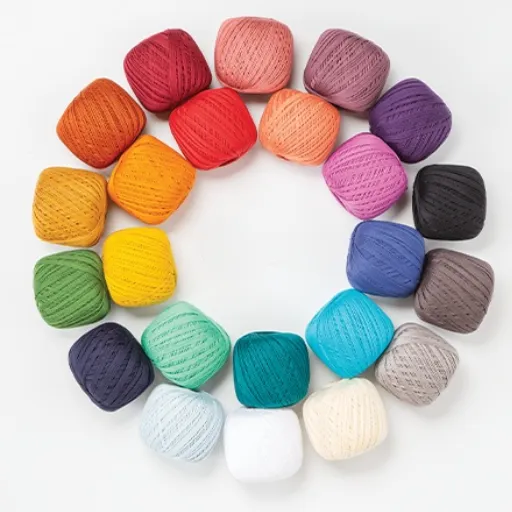
Different Varieties of Acrylic Yarn
Acrylic yarn features a wide selection of types, with each type designed for a specific crafting purpose. Among the most popular types is the standard acrylic yarn, which is lightweight, user-friendly, and comes in a vast array of colors. This is the best option that can be used for many projects such as scarves, blankets, and sweaters because it is affordable and durable.
Another type is the premium acrylic yarn, which has a softer texture and smoother stitches. The yarn of this kind is like the natural fibers in feel, thus it is suitable for projects where the comfort and an effect of luxury finish are wanted. Furthermore, a more refined acrylic process is yielding better yarns for wearing, the same as the standard needing frequent replacement due to the pilling which it couldn’t resist at times.
Lastly, there are the specialty acrylic yarns, one of which includes blends with other fibers, offering the extra warmth, elasticity, or just plain unique textures as added qualities. These mixtures are not only easy on the wallet but also possess the strengths of either natural or synthetic fibers, hence, a wider range of creative crafting projects that may be done. The right kind of yarn, however, is dictated by the interplay of factors such as cost, durability and the specific properties that your project will require.
Comparing Acrylic Yarn to Other Synthetic Yarns
Among synthetic yarns, acrylic yarn is the most preferred choice because of its low price, multiple uses, and softness. Whenever synthetic fibers like polyester or nylon are considered, acrylic is picked mostly for its wool-like quality, thus, it becomes a widely used alternative for yarn and more so for crochet projects. Moreover, being lightweight and warm it finds its way into garment and accessory making for cooler climates, while easy maintenance—machine washable and quick-drying—has added to its convenience.
| Synthetic Yarn Type | Key Characteristics | Best Use Cases |
|---|---|---|
| Acrylic | Soft, wool-like, lightweight, warm, affordable | General crafts, garments, accessories |
| Polyester | More durable, wear-resistant, less soft | Outdoor equipment, high-strength items |
| Nylon | Stretchy, moisture-resistant, strong | Swimwear, items prone to stretching/water exposure |
Acrylic usually feels softer and allows light to pass through it better than polyester yarn, however, on the other hand, polyester is more durable and resistant to wear and tear often making it the choice for projects that include outdoor equipment or items that need strength. Nylon, in comparison, is more stretched and moisture-resistant than acrylic thus it is a good choice for making swimwear or things that are prone to stretching or getting wet. The soft feeling and the low price of acrylic are its main advantages, thus it caters to the needs of people who want cost-effective solutions without being rough.
Acrylic yarn, even with its pros, still cannot compete with natural fibers or some synthetic counterparts in terms of breathability; this might render it an uncomfortable option for warmer regions. Also, when dealing with heavy-duty situations where yarn is required to be very strong, acrylic might not hold up as well as nylon or polyester in terms of tensile strength. There is no such thing as one way to go regarding the choice of the yarn between acrylic and other synthetic ones, as it mostly depends on the project at hand and the balance needed in terms of cost, comfort, and other specific characteristics.
Specialty Acrylic Yarn: Faux Fur and Others
Specialty acrylic yarns like faux fur have become top-notch and moslty used due to their exquisite textures and versatility in making various applications. The imitation fur yarn has captured the very softness and look of real fur, thus it is very nice for the creation of soft and warm projects like scarves, blankets and the like or even just additions to the decor. If not properly handled, the product can be so light and fluffy that one would feel it is just a lighter version of the real thing. Crafters do have the upper hand since these yarns come in a variety of colors and patterns that are greatly diversified and thus open up new areas of creativity to them.
Natural fur or more complicated synthetic materials have thus been a hard task for crafters due to the fact that they have to work with faux fur acrylic yarn which is easier to handle. In addition to this, the fluff is usually machine washable, durable, and resistant to shrinkage or fading, hence perfect for day-to-day items and long-lasting use. Besides, since it is made of acrylic, it is a cruelty-free option that attracts those who want ethical and sustainable alternatives.
✨ Other Specialty Acrylic Yarns Include:
In addition to faux fur, there are also other special acrylic yarns that come with glitter, metallic threads, or gradient color schemes that are the main reason for their visual beauty. These pretty yarns have the potential to turn a simple project into something extra, for example, by using shimmering accents to beautify through holiday decorations or making vibrant accessories by utilizing gradient transitions. So, by choosing the right specialty acrylic yarn, crafters can fulfill their specific aesthetic goals and at the same time enjoy the benefits of affordability and convenience that comes with acrylic materials.
Benefits of Using Acrylic Yarn
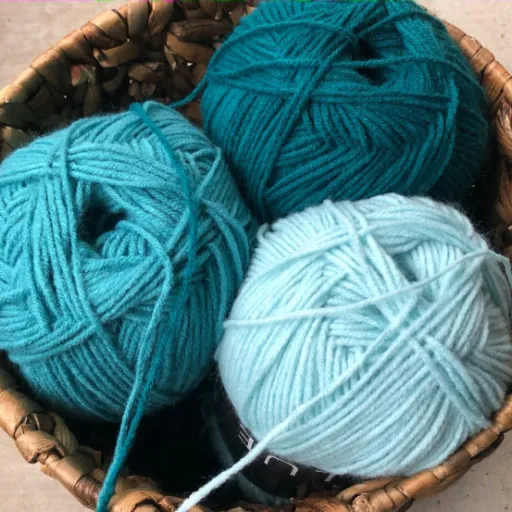
✓ Lightweight and Versatile
Acrylic yarn is lightweight, which is one of its benefits, hence it is suitable for almost all crafting projects. Being a lighter alternative to natural fibers like cotton or wool acrylic does not make a garment or accessory heavy and it still allows the costume to be seasoned effectively and be comfortable to wear. This eliminates the disadvantage of knitting or crocheting large items like blankets or sweaters larger where the balance between weight and warmth is very important.
✓ Affordability and Accessibility
Acrylic yarn is a prominent contender when it comes to affordability, thus being the first choice for crafters with limited budgets. It is much cheaper than natural fibers like wool or cotton but still gives the same quality and versatility. Thus, this cost-effectiveness benefits not only the hobbyists but also the whole industry by allowing large projects or buying in bulk without going broke.
✓ Color Variety and Durability
Acrylic yarn is no doubt the best option for crafters in search of creative flexibility due to its extensive range of colors. It comes in every color imaginable, from super bright to softly pastel, and thus can be used for different types of projects. Apart from that, there is the possibility of easy dyeing of acrylic fibers, which ensures that the crafters have access to a limitless palette to express their artistic ideas.
Versatility in Detail
Versatility is another plus point of acrylic yarn. It comes full of colors, textures, and finishes which tempt the crafters to explore and go wild with their ideas. No matter if you are making delicate baby outfits, loud fashion statements, or intricate home decorations, acrylic yarn is full of opportunities and it easily fits different project types and styles.
To further add to the appeal of acrylic yarn is its compatibility with various stitches and techniques. It doesn’t lose form and can be used in everything from soft lace to firm, close weaves. That plus its endurance and easy care makes acrylic yarn a preferred choice by both novice and professional crafters over other materials.
Accessibility Advantages
Another major plus point of acrylic yarn is its widespread availability. It comes in many different colors, textures, and weights, which is certain that there will be something for every project. The major craft and hobby stores always have a pretty good selection of acrylic yarn and, in fact, they also have an online presence where customers can buy it easily and get shipping done at their convenience. This widespread availability guarantees that the crafters will get what they need quickly, no matter if they are involved in small personal projects or large-scale designs.
Finally, the consistent and cheap-to-get acrylic yarn makes it a perfect material for teaching and beginner-friendly crafts. The teacher and students in knitting or crocheting classes always depend on acrylic yarn for its low cost and easy to work with properties. Moreover, these characteristics help to nurture creativity, as the crafters can generously experiment without the fear of wasting their precious materials. In the end, combined affordability and accessibility have made acrylic yarn a classic crafting material suitable for all skill levels.
Long-lasting Quality
Another defining characteristic of yarn made of acrylic is durability. It can withstand tremendously and still remain in good condition after many uses and washings. For this reason, the yarn can be used for making blankets, clothes, and other items that need to last long, since it is resilient. It also resists fading and shrinking, thus keeping the original look and feel of the finished pieces with time.
The combination of color variety and durability results in acrylic yarn being a practical option for all types of crafters – beginners and experienced ones alike. Its low-maintenance nature makes it so that the projects that are already finished continue being vibrant and intact with little effort, thus making it an accessible and trustworthy material for countless crafting efforts.
Drawbacks of Acrylic Yarn
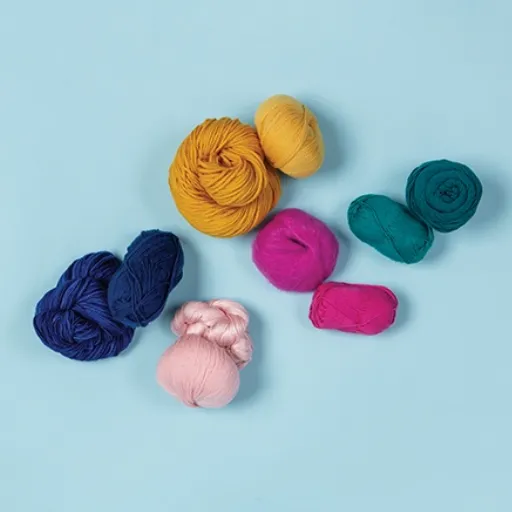
Synthetic Yarn: Its Potential Pitfalls
⚠️ Important Considerations:
Acrylic yarn, although to its advantages and cheap, must still be considered because of the possible drawbacks accompanying it. Breathing is one of the major disadvantages that synthetic fibers have when compared to natural fibers. Most importantly, clothing or blankets made of acrylic would not be good in places with warm climates or where the activity is high because the synthetic material would not wick moisture as good as cotton or wool would.
Acrylic yarn is, again, criticized for its impact on the environment. The fact that it is made from petroleum-based products, thus, being non-biodegradable and less ecological than natural fibers like wool or cotton, is one of the main reasons. Furthermore, laundering acrylic releases microplastics which end up in water bodies thereby causing pollution. Consequently, the environment has a direct influence on the choice of materials among the craftsmen who are eco-conscious.
Furthermore, the touch of acrylic yarn is found by some users to be less than the touch of natural fibers—especially if the yarn is of the lower quality. The comfort of the finished product will be affected, especially in the case of items worn next to the skin. Credited to the advancements in manufacturing, some acrylic yarns (especially) have improved in softness but it still might not be the case for every crafter or the recipient in terms of the expectations of the tactile.
Acrylic Yarn vs Wool Yarn: Pros and Cons
While discussing the two, acrylic yarn and wool yarn have their unique pluses and minuses, thus being appropriate for different uses and tastes. Thus, knowing these contradictions can be a great help to the makers in picking the proper yarn for their works.
| Yarn Type | Advantages | Disadvantages |
|---|---|---|
| Acrylic Yarn | – Very affordable – Machine washable – Long-lasting and durable – Resistant to moths and mildew – Easy maintenance |
– Less breathable – Doesn’t wick moisture well – Not as warm in cold weather – Less comfortable in warm climates |
| Wool Yarn | – Exceptional warmth – Natural breathability – Temperature regulating – Biodegradable and renewable – Natural elasticity |
– More expensive – Requires special care – Can shrink if not washed properly – May feel scratchy (except softer varieties) – Needs hand washing or gentle cycles |
One of the main virtues of acrylic yarn is that it is very cheap to buy and easy to maintain. It can be washed in a washing machine, it is long-lasting and it doesn’t get attacked by moths or mildew, therefore it can be used for cleaning or heavy usage for items like blankets, scarves, or hats. However, because the production of acrylic yarn requires synthetic fibers, it cannot avail itself of the natural advantage of breathability and moisture-wicking that wool has. This can be a reason why acrylic is less comfortable for skin contact garments in warm atmospheres.
Wool yarn, on the contrary, is known for its unparalleled warmth, stretchiness, and natural heat-retaining property. Taking the best advantage of its body temperature-regulating ability, wool is suitable for making sweaters, socks, and other kinds of clothing destined for cold weather. Moreover, wool is biodegradable and a renewable resource, which makes it a less damaging to the environment choice. However, one downside of wool is that it can sometimes require very special care as it tends to shrink and thus may need either hand washing or cleaning with very gentle techniques. Besides, some people find wool scratchy, however, that is not the case with the softer kinds like merino which are quite comfortable.
🎯 Decision Guide: At the end of the day, whether to go for acrylic or wool comes down to project purpose, recipient, and personal tastes. When the right yarn for your crafting needs is being selected, factors such as budget, maintenance, and the desired appearance and texture should be taken into account.
Environmental Considerations
The comparison of acrylic and wool in terms of the environment must take into consideration the 3 aspects: their production, the actual environmental impact, and their disposal. Wool is a natural fiber, thus, it is biodegradable and a renewable resource. Wool is sustainable if the sheep are shorn regularly and raising the sheep is done with care, creating an ecological environment. Moreover, the wool is composted and sends nutrients back into the earth while being free of toxic substances.
In contrast, acrylic is a synthetic fiber made from petroleum, a non-renewable resource. The production of acrylic is not only energy consuming but it also results in the release of greenhouse gases, thus, being a major environmental issue. On the contrary, acrylic is not biodegradable and often remains a long time in nature thus, it might be one of the contributors to microplastic pollution. The disposal of acrylic textiles mostly leads them to landfills or they are being sent to recycling where the facilities might not be commonplace.
Think of wool and acrylic as the two materials to choose from not only according to the possible crafts but also based on the environmental impacts of each. Moreover, the use of responsibly sourced wool from sustainable farms or the reduction of petroleum-based fibers can be the solution for making the crafting projects more environmentally friendly. The weighing of these factors guarantees smart, eco-friendly choices that are also compliant with the needs of any project.
Applications of Acrylic Yarn
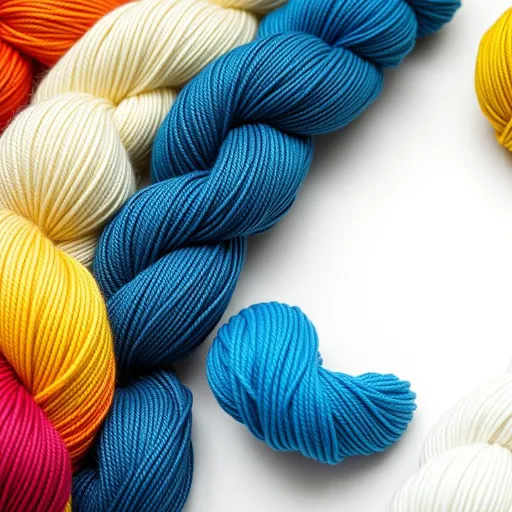
Common Projects for Knitting and Crochet
Knitting and crochet projects made with acrylic yarn showcase endless variety and versatility due to the long-lasting and inexpensive nature of the fiber. The most common thing to do with it is to make garments such as sweaters, scarves, and hats, which can be quite warm, soft and resistant to shrinkage during washing thanks to the properties of the yarn. Just as the same, acrylic yarn is light in weight hence suitable for projects that are going to be worn or used daily.
Home décor items also feature among the top choices of projects done with acrylic yarn. Among the popular home items are throws, cushions, and carpets because acrylic is not only colorful but also very easy to match up with different interior styles. Moreover, the low price of acrylic yarn allows one to make large items like afghans or throws without spending more than the planned amount. Being made of acrylic, these items will last long and stay beautiful even after being used frequently.
Acrylic yarn is a favorite among beginners for simple projects such as dishcloths or small toys like amigurumi. Its user-friendliness and availability make it a good material for practicing techniques at low cost. These projects serve as a gateway to more complex undertakings, showcasing the broad applications of acrylic yarn in both functional and decorative crafting.
Items Created Using Acrylic Yarn
The acrylic yarn material deserves to be called versatile as it can produce an enormous range of items, both lovely and practical at the same time. The most common application of this material is making thick, warm, and soft blankets, scarves, and hats, which are in great demand for their comforting feelings. All these items having the same features of durability and easiness in washing are therefore perfect for daily use or even for gifting pleasantly as they are handmade products.
Acrylic yarn is beyond garments’ use and is a typical choice for home décor projects. Such will bear witness to throw pillows, rugs, and wall hanging that can be dynamic and colorful to any area. Crafters can easily come up with nice and colorful combinations with the affordable acrylic yarn colors and textures giving them an unlimited scope of their art.
Additionally, the crafters’ world does include plenty of fun and hysterical activities where acrylic yarn is the main character, such as do-it-yourself amigurumi and small pouches and bags via knitting. These creators get both their imaginary expression and acrylic yarn’s vibrant color options of being…
The use of acrylic yarn in the crafting world is majorly due to its long-lasting qualities and the limitlessness of the potential it offers.
Using Acrylic Yarn for Specific Techniques
Acrylic yarn, with its many different properties, is still the most common choice among all crafting materials. Knitting yarn for beginners, mainly because of its uniformity, good holding of stitches, and the fact that it does not go unnoticed. By the way, the yarn is so light that it is good for small accessories: scarves, hats, or mittens. It also shrinks and stretches very little, thus ensuring that the finished products are always in good shape.
Acrylic is the best yarn for crocheting when we want sharp and difficult designs. Thanks to its stretchiness, makers can create patterns that are strong and last for a long time, no matter if they’re simple or complex. The variety of colors that acrylic yarn provides is very important in crocheting, since it lets the artists play with gradients, contrasts, or bright colors to make their dreams come true. Its price and availability further support the justification for choosing it for large-scale projects such as blankets and pillow covers since it is not only cheap but also easily available.
🧶 Advanced Techniques:
Acrylic yarn has many other specialized applications such as in loom weaving and amigurumi. In the case of loom weaving, the yarn’s uniformity gives the processor the assurance of receiving the same quality each time while its strong nature helps to keep the quality of the finished work for a longer period. Amigurumi, the meticulous art of making stuffed figures, is greatly helped with the use of acrylic yarn because of the wide selection of colors and the long-lasting nature of the yarn, allowing the artist to effortlessly create even the most intricate characters with a lot of detail. Hence, these characteristics make acrylic yarn the very core material for all artists and their creations regardless of the technique.
Frequently Asked Questions (FAQ)
Q: What is acrylic yarn?
A: Acrylic yarn is a synthetic fabric made up of the polymer acrylonitrile. It is not only cheap but also very versatile which is why it is often selected by knitters and crocheters. The majority of acrylic yarns are made to mimic the properties of the natural fibers like wool and cotton so that crafters find it easier to work with them.
Q: What are the differences between acrylic yarn and natural fiber yarns?
A: One of the greatest differences is that acrylic yarn is a man-made fiber while the rest, such as wool and cotton, are natural fibers. This means basically that the latter come from plants or animals while the former is plastic. This can also have an impact on the tasting, air-permeability and heat-insulating properties of the yarn made items.
Q: Is acrylic yarn hypoallergenic?
A: One of the reasons why acrylic yarn is recommended as the top choice for users with allergic reactions to wool is its hypoallergenic property. Synthetic fibers lack the same proteins as natural fibers that are the cause of allergic reactions, so knitting and crocheting are worry-free for sensitive skin.
Q: What types of projects can I use acrylic yarn for?
A: The range of applications of acrylic yarn is practically unlimited when it comes to knitting and crocheting projects that consist of clothes, accessories, even home décor items. The characteristics of the yarn such as being long-lasting and easy to care for have led to creating items like blankets, hats, and scarves.
Q: How does acrylic yarn compare to cotton yarn?
A: A comparison of acrylic and cotton gives rise to several differences. Cotton yarn, being wholly natural, is better ventilated while acrylic yarn per its synthetic nature is less expensive and more user-friendly. On the other hand, cotton yarn has the upper hand in terms of moisture absorption so it is also cooler to wear.
Q: Are there any cons of acrylic yarn?
A: Acrylic yarn gets rid of many of the drawbacks that come with the use of synthetic yarns by being more economical and comfortable to take care of but it has some disadvantages too like pilling and not being so warm as natural fibers. Also, acrylic yarn can sometimes feel less airy and thus it gets unfit for use in hot weather.
Q: Can I use knitting needles and crochet hooks with acrylic yarn?
A: Knitting needles and crochet hooks can be used with acrylic yarn, and most of the crafters tend to say that it is the material for beginners. The soft feel of the yarn aids sewing, thus it is loved equally by starters and pros.
Q: What considerations should I have when storing acrylic yarn?
A: In order to prevent quality loss and damage to acrylic yarn, a cool, dry place away from heat and sunlight is paramount for its storage. Moreover, to keep future projects hassle-free, nothing beats a neat and organized yarn.
Q: What is the best way to care for items made with acrylic yarn?
A: Acrylic yarn items are typically quite easy to care for. The majority of them can be machine-washed and dried; however, it is always advisable to check the care instructions accompanying that particular yarn. Washing in cold water and using gentle cycles can also result in prolonging the use of the final product.
References
- 📚 Acrylic Vs Cotton Yarn – What’s The Difference? – Discusses the properties and differences of acrylic yarn compared to cotton yarn.
- 📚 Acrylic fiber – Wikipedia – Provides an overview of acrylic fibers, including their composition and characteristics.
- 📚 What Is Acrylic and Synthetic Yarn and What Is It Made Of? – Explains the materials and processes involved in making acrylic yarn.
- 📚Acrylic Yarn vs Wool: Which is Better? – Compares acrylic yarn to wool, highlighting their advantages and disadvantages.
- 📚 What is Acrylic Yarn Made Of: Understanding Acrylic Fiber – Offers insights into the production and history of acrylic yarn.








